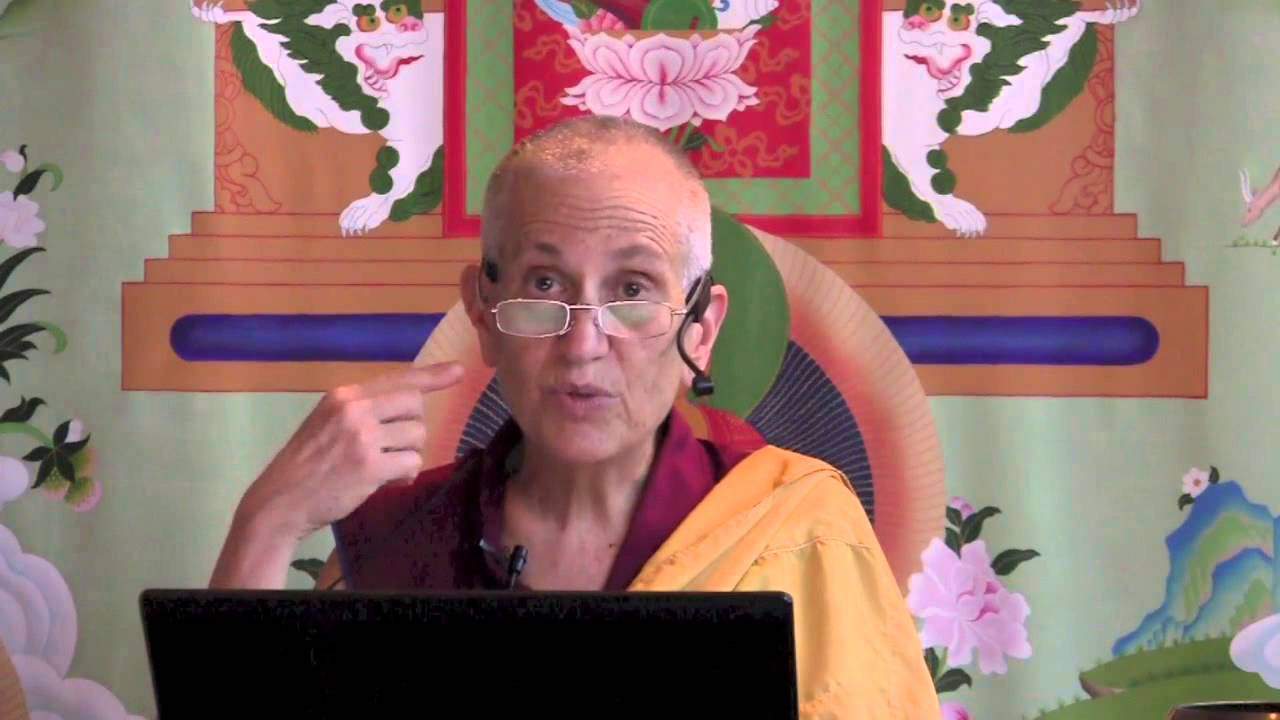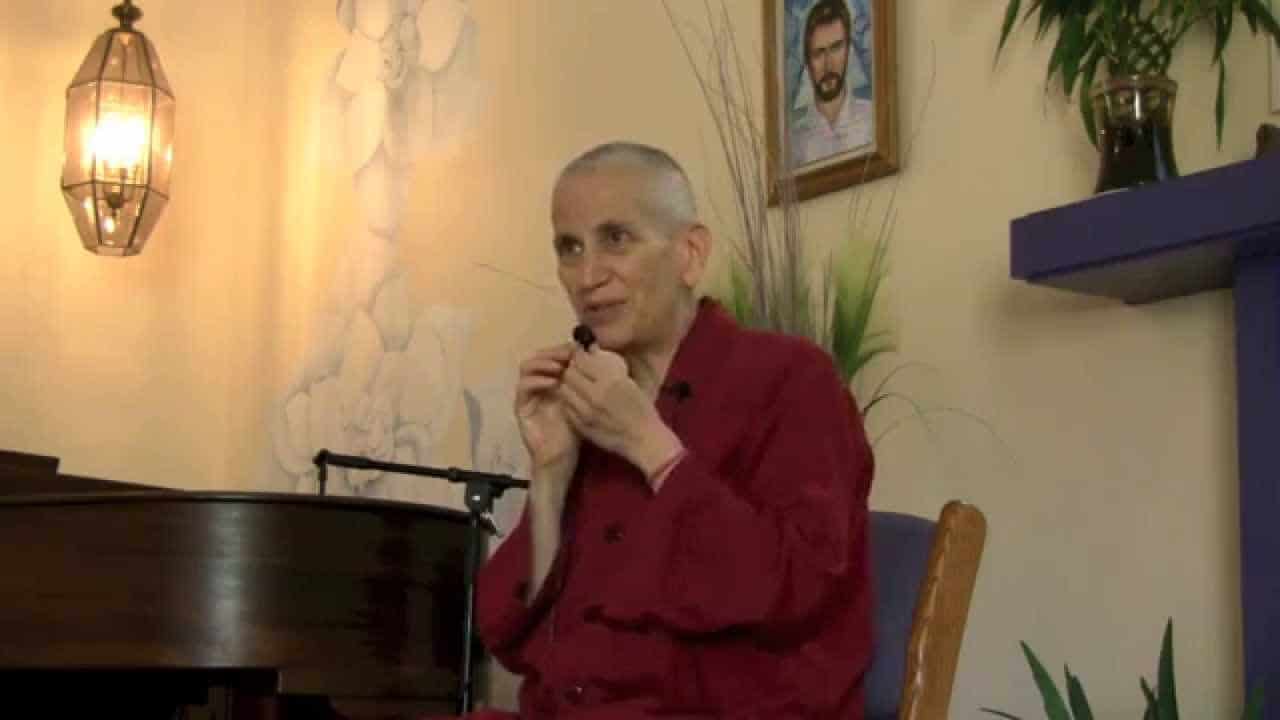Taking refuge in the Three Jewels
Part of a series of teachings on the text The Essence of a Human Life: Words of Advice for Lay Practitioners by Je Rinpoche (Lama Tsongkhapa).
- What taking refuge means
- How refuge grows with time
- Seeing the qualities of the Three Jewels
- The role of faith in Buddhism
The Essence of a Human Life: Taking refuge in the Three Jewels (download)
With such thoughts make efforts in refuge,
“Such thoughts” (in the previous verse) referring to contemplating that our virtuous actions lead to happiness, our nonvirtuous actions to suffering.
Live as best you can in the five lifelong precepts,
praised by Buddha as the basis of lay life.
Take sometimes the eight one-day precepts
and guard them dearly.
First contemplate a precious human life, and death, and then karma, then Je Rinpoche is saying for lay practitioners—and also for monastic practitioners—the next thing to do is, seeing that you are in a clearly unstable situation, not knowing where you’re going to get reborn, and completely under the control of previously created karma that we don’t know how in the world it’s going to ripen, then because of that we need to seek guidance, and so we seek guidance from the Three Jewels. And the first thing the Three Jewels tell us to do to improve our situation is to take and keep the five precepts. And then if we can, to do the one-day precepts from time to time.
The first instruction here is to turn to refuge to the Buddha, Dharma, and Sangha. Refuge means really getting clear in our own minds what tradition we’re following, whose teachings are we following, what direction are we going in spiritually, having a very clear idea where we’re going.
While it’s so easy for us to say, “I take refuge in the Buddha, and the Dharma, and the Sangha,” actually taking refuge means understanding deeply what the Buddha, Dharma, and Sangha are, why they are reliable sources of refuge, and why it will benefit us to rely upon them. To actually understand that we have to do some study and learn the qualities of the Buddha, Dharma, and Sangha.
I remember when I was a baby Buddhist, and as a baby Buddhist I had a little bit of understanding, but not very much. And I remember one of the senior Tibetan monks in Kopan coming into the office one day (because I used to be the office manager)—and it was before it was one of the big November courses, so there were a lot of Westerners coming up—and I remember him saying, “When these people hear about the miraculous and wonderful qualities of the Three Jewels, they will definitely take refuge.” And I remember thinking, “Not me.” Just hearing about wonderful qualities, for me, doesn’t necessarily inspire faith. I have to know how it is possible to develop those qualities, and then I can have faith that some people have them. This is just the way my mind thinks.
If somebody’s telling me about someone else—”oh they’re this this this this”—I want to get to know them so I can see what they’re really like. And maybe that’s because in the religion I grew up with there were already a lot of holy figures who had a lot of excellent qualities, but what I was really looking for was how is it possible to get these qualities. So descriptions of people having miraculous abilities, or superknowledge, or whatever, for me personally that didn’t inspire faith in the Three Jewels, because the religion I grew up with had lots of miracles and these kinds of things going on as well. So when I came to Buddhism, I really wanted to know, “How is it possible to develop these qualities?” And if I knew how it was possible, then I could accept that the Buddha existed. Because I came in: “How do you have equal-hearted love and compassion for everybody? How in the world do you get your mind to be like that?” Nobody had ever taught me how. And I didn’t understand how that was possible.
So for me personally, I didn’t grow up in a Buddhist family, so I don’t have that kind of instinctive faith that you often get from your childhood, but I wanted to know, “How do we know it’s possible to develop these qualities?” Because then I’ll believe other people have it, and then I’ll believe I can gain those by practicing that path too. But without knowing that, why should I trust what they’re saying, and why should I practice that path? Or at least why should I practice that path with a lot of vigor.
I remember in the early years I was going, “How do I know the Buddha really exists? Lots of people say so, but how do I know?” I’m just telling you the way my mind works. Everybody’s quite different. So for me what the growth of faith very much depended on was having some personal taste of the teachings. So when I practiced the antidotes to anger, or to self-centeredness, or to attachment, and I saw that they had a positive effect on my mind and lessened my attachment and my anger even just this much [a little bit], and my selfishness, then that instilled faith in me that that path worked because the little bit that I had practiced worked. And then that helped me think, “Well, maybe it’s possible to become like some of these holy beings.” But it really took a lot of time. It started that way with my own personal experience, and then later as I studied more and I began to understand the layout of the path, and what the mind was, and what the hindrances are (or obscurations to the mind are), and how those get removed, then that gave me much more confidence and faith and trust that there were holy beings and there was a path that worked.
For me, I took refuge early, but it really is something that grew over the years and is still growing now. We may take refuge in a ceremony, and that’s the official thing that makes you a Buddhist, but I think refuge is really something that we learn about and deepen our understanding of all the way until we become the Buddha, Dharma, and Sangha.
First we realize the Dharma. Then we become an Arya Sangha. Then, last, we become a buddha. But I think it’s a process that grows until we become the Three Jewels ourselves, in our own mindstream.
It has to start with our own personal experience. At least for me. Now, to get some personal experience it means you have to do some meditation practice. And you have to learn to work with your mind. At least for me, just study helped a great deal, but it certainly wasn’t sufficient to generate some kind of confidence that this path worked.
Let’s think about that for a while. Then in the future days I’ll talk a little bit about the qualities of the Buddha, Dharma, Sangha, instead of going into that right away. Talk about how we generate that.
Because in Buddhism faith does not mean unquestioning faith. It doesn’t mean acceptance without investigation. There are three kinds of faith. The first kind, we admire the qualities of the Three Jewels. The second, we aspire to gain those qualities ourselves, and the third is based on conviction that the path is possible and from some understanding of the path. So faith (or also translated as trust or confidence) is something that grows in us that has causes. And we have to create the causes for it. Some people do it by, “I have respect for my teacher, and my teacher said this, so I believe it.” But those are what are called more “modest faculty” disciples, who accept it because somebody else said so. But if we want to penetrate more deeply then we have to investigate for ourselves.
And I’ll give you a clue: I didn’t know this at the beginning, because I was just basing it on trying to apply some of the gross antidotes to my afflictions, and that’s what started giving me some faith. But the real thing that gives some faith in the existence of the Three Jewels is understanding emptiness. And Nagarjuna presented a whole rationale explaining how that works. And when we do the course Buddhism: One Teacher, Many Traditions, I’ll go into it there because it’s explained in that book.
Venerable Thubten Chodron
Venerable Chodron emphasizes the practical application of Buddha’s teachings in our daily lives and is especially skilled at explaining them in ways easily understood and practiced by Westerners. She is well known for her warm, humorous, and lucid teachings. She was ordained as a Buddhist nun in 1977 by Kyabje Ling Rinpoche in Dharamsala, India, and in 1986 she received bhikshuni (full) ordination in Taiwan. Read her full bio.


